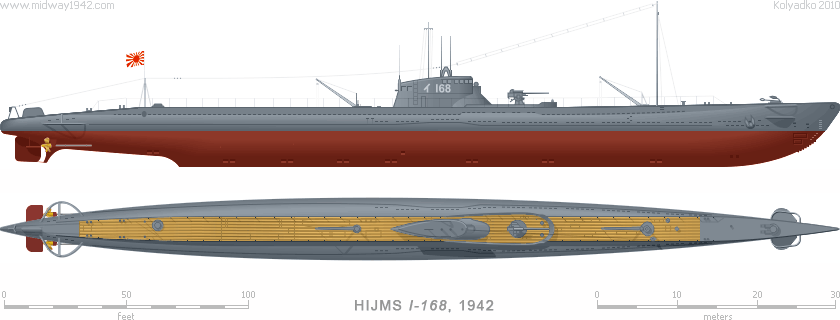
| Kaidai VI class, 海大六型 | SUBMARINES, 潜水艦 | |

| Displacement: | 1,785 t Surf., 2,440 t Sub. | Machinery: | 2 diesels, 2 electric motors, 2 shafts | Bow Torpedo Tubes: | 4×21 in (533 mm) | |||||||
|---|---|---|---|---|---|---|---|---|---|---|---|---|
| Max Length: | 343 ft 6 in | 104.7 m | Power Surf./Sub.: | 9,000 / 1,800 hp | 6711 / 1342 kW | Aft Torpedo Tubes: | 2×21 in (533 mm) | |||||
| Beam: | 26 ft 11 in | 8.2 m | Speed Surf./Sub.: | 23 / 8.25 kts | 42.6 / 15.3 km/h | Torpedoes: | 14×Type 95 | |||||
| Draft: | 15 ft 0 in | 4.6 m | Range Surf./Sub.: | 14,000 / 65 nm | 26 000 / 120 km | DP Gun: | 1×3.9 in (100 mm)/50 | |||||
| Complement: | 70 officers & enlisted | Operating Depth: | 245 ft | 74 m | AA MG: | 1×.52 in (13.2 mm) | ||||||
* Specifications for Kaidai VIa subtype, early production (I-168—I-170).
The initial design of IJN “Navy Large Type Submarine” (was shortened to Kaidai) was based on the German U-139 class long-range submarine commerce raiders from WWI. Thirty-five ships of the type were divided into seven classes, Kaidai I-VII.
Eight submarines of the Kaidai VI class were completed between 1934 and 1938. The ships were longer and fitted with more powerful diesels than their predecessors, so these boats had the highest surface speed of any submarines in the world in the mid-1930s. The submarines were armed with six 21 in (533 mm) torpedo tubes and fourteen lethal Type 95 kerosene-oxygen torpedoes. The first three boats carried the 3.9 in (100 mm) gun, the last five mounted a 4.7 in (120 mm) deck gun. All boats were also equipped with one or two .52 in (13.2 mm) anti-aircraft machine guns.
The class was active during the Midway operation when I-168 scored the biggest Japanese submarine success of the war when she torpedoed and sank the already damaged fleet carrier USS Yorktown (CV-5), and destroyer USS Hammann (DD-412) off Midway on June 6.
| Ship | Builder | Laid Down | Launched | Commisioned | Fate | |||||||||||||
|---|---|---|---|---|---|---|---|---|---|---|---|---|---|---|---|---|---|---|
| 伊一六八 | I-168 | Kure Naval Arsenal | 18 | Jun | 1931 | 26 | Jun | 1933 | 31 | Jul | 1934 | Sunk in action | 27 | Jul | 1943 | |||
| 伊一六九 | I-169 | Mitsubishi, Kōbe Shipyard | 22 | Dec | 1932 | 15 | Feb | 1934 | 28 | Sep | 1935 | Sunk in action | 4 | Apr | 1944 | |||
| 伊一七十 | I-170 | Sasebo Naval Arsenal | 25 | Jan | 1933 | 14 | Jun | 1934 | 9 | Nov | 1935 | Sunk in action | 10 | Dec | 1941 | |||
| 伊一七一 | I-171 | Kawasaki, Kōbe Shipyard | 15 | Feb | 1933 | 25 | Aug | 1934 | 24 | Dec | 1935 | Sunk in action | 30 | Jan | 1944 | |||
| 伊一七二 | I-172 | Mitsubishi, Kōbe Shipyard | 16 | Dec | 1933 | 6 | Apr | 1935 | 7 | Jan | 1937 | Sunk in action | 10 | Nov | 1942 | |||
| 伊一七三 | I-173 | Kawasaki, Kōbe Shipyard | 5 | Sep | 1933 | 20 | Jun | 1935 | 7 | Jan | 1937 | Sunk in action | 27 | Jan | 1942 | |||
| 伊一七四 | I-174 | Sasebo Naval Arsenal | 16 | Oct | 1934 | 28 | Mar | 1937 | 15 | Aug | 1938 | Sunk in action | 12 | Apr | 1944 | |||
| 伊一七五 | I-175 | Mitsubishi, Kōbe Shipyard | 1 | Nov | 1934 | 16 | Sep | 1936 | 18 | Dec | 1938 | Sunk in action | 17 | Feb | 1944 | |||